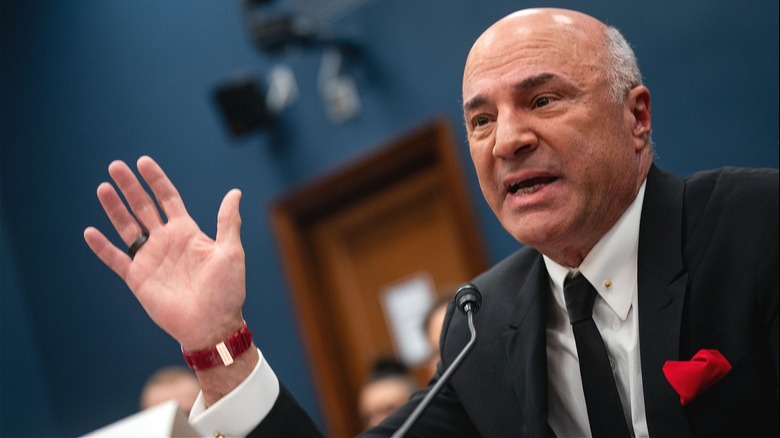Is Kevin O'Leary's Debt-Free-By-45 Advice Realistic?
When it comes to financial advice, there's no shortage of tips, tricks, hacks, and recommendations. However, following all of this various advice can feel downright impossible, and this can leave you wondering who to listen to, and what advice to follow for your financial future. Many choose to put more stock (pun intended) in the advice of celebrities and/or successful businesspeople. This might have led you at some point to talking heads like Kevin O'Leary, a businessman, financial writer, and (perhaps most famously) an investor on ABC's "Shark Tank" (this is the worst deal O'Leary says he ever made on the show, by the way). While O'Leary, and other financial talking heads like him, often bring years of personal financial expertise to their recommendations, they're not necessarily realistic or in touch with the realities of many Americans. This can make their so-called expert advice less than helpful for most people.
This brings us to O'Leary's debt-free advice. When asked when a person should plan to have all of their debts paid off, O'Leary claimed by age 45. He explained to CNBC Make It in 2018, "The reason I say 45 is the turning point, or in your 40s, is because think about a career: Most careers start in early 20s and end in the mid-60s. So, when you're 45 years old, the game is more than half over, and you better be out of debt, because you're going to use the rest of the innings in that game to accrue capital." While, on the surface, this advice makes sense, let's dive into the factors that ultimately make it unrealistic.
America's current debt numbers
A big part of the fallacy of Kevin O'Leary's financial guidance that a person should be debt-free by 45 has to do with the many ways debt has changed in recent years, making it more common (and in larger quantities) for more people. Let's start by breaking down the current level of debt in the U.S. Not only is the country facing some of the highest credit card debt in history, but the total household debt hit a whopping $17.3 trillion at the start of 2024. This includes everything from mortgages to student loans to credit cards.
To go back to credit cards, specifically, a Bankrate survey found that 47% of U.S. borrowers were carrying their credit card balances over each month in 2023, with 60% carrying a debt balance for at least a year. Given that the current average credit card interest rate is 27.7% (as of mid-June 2024), this means that a substantial number of people are paying exorbitant amounts of interest on top of their debt.
On top of this, student loan debt currently affects over 43 million people, and the total student loan balance in the United States has almost tripled over the last 15 years (it was $545 billion in 2007 and is almost $1.75 trillion in 2024). Since 2014, the student loan debt balance in the U.S. has increased 66%. Finally, housing prices in the country have continually risen, with a 54% increase since 2019, meaning that mortgages (and payments) are also higher than ever (not to mention how this Federal Reserve committee is affecting interest rates).
The retirement factor
In addition to debt, Americans are also looking at significant changes to retirement. Not only do younger generations experience money-phobia from the idea they'll never get to retire, but Social Security is due to be depleted in 2034, leaving many unsure about their retirement prospects.
Returning to Kevin O'Leary's debt-free-by-45 advice, his premise is predicated on the out-of-date idea that a person is going to retire by their mid-60s. Not only has the Social Security Administration already moved the full retirement age to 67 for everyone born on or after 1961, but, increasingly, it's also added incentives for those who choose to delay their retirement even longer. Currently, those who wait until age 70 to retire receive an 8% boost to their benefits each year. Policymakers have even suggested continuing to push the age of retirement back, despite the harm this could cause for low-income workers and the effects this could have on younger generations.
It's also worth noting that O'Leary's debt-free advice assumes a person begins their career in their early 20s. However, education-work pipelines have largely failed younger generations (millennials, in particular) with many not finding good jobs until their 30s. On top of this, women and people of color are still disproportionately affected by job market limitations. Not only do women still earn just 82 cents for every dollar earned by men, but this pay gap only increases as women age. This means women generally tap out with their highest salaries around age 40 while men continue to receive raises, hitting salary peaks closer to age 55.


